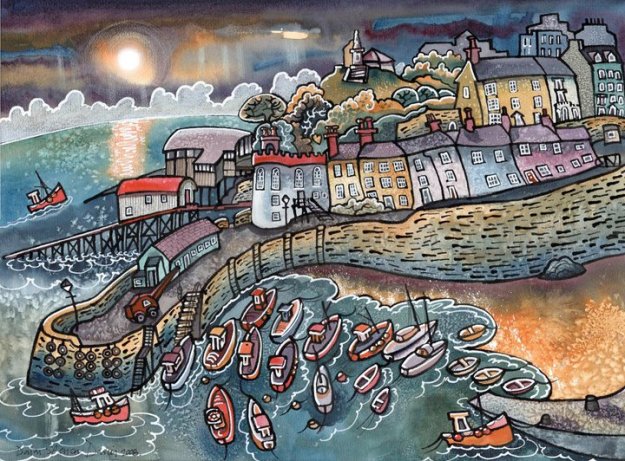Dylan Thomas is probably best know for his poems of sublime beauty set amidst the simple, beloved people who live in the seaside village of Swansea in Wales. The poems ring clear and majestic, with a rhythmic zeal. Not surprisingly, the short stories of Dylan Thomas read much like his poetry. They are exquisite tales told with the same passion and Welsh cadences that evoke a mixture of exhilaration and simplicity, delight and tragedy, not unlike the stories of James Joyce, whom Thomas loved and revered.
After the Fair draws a parallel to Joyce’s oft-emulated story from the Dubliners, Araby. Indeed, Thomas’ story seems to begin where Joyce’s Araby leaves off: at the village fair after it has closed up for the night. Instead of a boy who stands in the open isles under the night sky, the main character is a little girl who appears to have no home. Somewhat dark and mysterious, the tale carries a sublime, fantastic air, as do many of Thomas’ stories. A girl who is brave but also scared, she makes her way through the shadows cast by the wooden horses.
“Once she stepped on the boards; the bells round a horse’s throat jingled and were still; she did not dare breathe again until all was quiet and the darkness had forgotten the noise of the bells.”
The Fat Man from his humble, lighted doorstep says into the night, “Who?” “Who?,” after the girl has knocked on his window and then hides. When she hears his thin voice, she laughs. The story is quick and playful with suspense and a merciful kindness.
The sparse dialog somehow creates the impression of a great deal of communication between the girl and the Fat Man. They innocently become fast friends as they toast bread inside his tiny, mirthful hut. At the end of the story, there is the ever-present epiphany, which Joyce invented and Thomas developed in his own style.
In all of the Collected Stories, there is the feeling of lines being blurred between fantasy and reality, of dream-recollection or heightened imagination. With Brember, from Thomas’ Early Stories, the theme from Joyce’s Araby emerges in the shadows of the rooms in an old house. As if the boy in Araby had returned as a grown man to the house of that earlier story.
Shadows flickering above the man’s taper candle and the pale moonlight coming in through the windows, a sad pathos imbues the room and the man’s memories:
There were tears in his eyes, a great longing for something he had known and had forgotten, loved but had lost.
It is a ghostly story, animating inanimate things, which is part of Thomas’ poetic brilliance. Many of his stories are autobiographical: about a boy and the quirky, loveable and often complex people living in Swansea. The stories are highly crafted, blending the ghostly and the suspenseful; the humorous and the tragic; and pathos with enchantment. The tales involving a boy are comparable to Joyce’s Dubliners, they cling to the drama and innocence of childhood, the enlargement of life that Thomas sang of in so much of his poetry.
As, In the Garden, the boy loves the garden but is afraid of it at night. He imagines the dark trees talking to one another. And he hates the nighttime summer bugs that fly into the kitchen, especially, the great grey moths that blundered round the room, for he knew they were in league with the things in the garden outside.
Here, in the garden, the trees and the groping shadows take on an animated life in the boy’s imagination. His racing mind invents a fantastical world of looming darkness, mystery and treasures. The boy really feels the effects of his imaginings:
… he was more afraid than he thought he could ever be. The garden writhed about him, and the walls and the trees shot upward so that he could not see the sky. The pointed roof of the summerhouse shot up the dark like a steeple hat.
These earlier tales are often ghost stories with a sublime ending, while the stories in Portrait of the Artist as a Young Dog, which are clearly dedicated to James Joyce, are most often comedies. As with The Peaches – A bitter-sweet tale of class and strife, addressing friendship, religion and sexuality told with Thomas’ distinctive Welsh humor.
At the end of the Collection are what I would call The Beautiful Tales and his most beloved tales, as Quite Early One Morning and A Child’s Christmas in Wales, which Thomas broadcast via the BBC as well as to audiences in America. Like Dickens, Thomas read his own work to an adoring fan-base. Listening to recordings of Dylan Thomas reading his poetry is to better understand his meaning. It is a very moving experience. He read with eloquent passion and a glory to life and living that is welcome today more than ever.
After hearing some of the poems by Thomas in his own melodious and burly Welsh tongue, you can hear his voice in reading his stories. The lilting accent, the magical, textured language soaring down through the years as if from a cathedral. It is the simple, common scenes animated to life with rhythmic word play and clever personification that endear us most, as in The Followers:
The thin, dingy rain spat and drizzled past the lighted street lamps. The pavements shone long and yellow. In squeaking galoshes, with mackintosh collars up and bowlers and trilbies weeping, youngish men from the offices bundled home against the thistly wind –
In another paragraph, the word hollow or hallowed is used four times. Instead of sounding too repetitive, this lends a unique drama. As with his poetry, such poetic devices as repetition and elegiac sound-patterns enhance the writer’s artistry. If the poems evoke the pathos Thomas intended, then his stories will inspire a deep love for his mastery of invention and story-telling craft.


